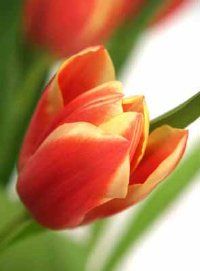The tulip is the most popular of the spring-flowering bulbs. It also offers the greatest variety in color, shape, and form of any bulb. Although tulips are associated with Holland, they actually are not native there; tulips descend mostly from species originating in the Middle East.
Description of tulip: Tulips typically bear cup-shaped flowers in almost every shade but true blue. They can be double or single, fringed or twisted, perfumed or nonscented. The plants range in size from rock garden miniatures to 2 1/2 feet or more in height. Most have broad leaves that quickly fade away in summer heat. Individual flowers last barely two weeks. However, since tulips offer various flowering seasons, you can have tulips in bloom from snow melt to the beginning of summer. Ease of care: Easy.
Advertisement
Growing tulip: Plant bulbs 5 to 8 inches deep (less for tiny species tulips) and 4 to 6 inches apart in a sunny, well-drained area. Plant in fall, then water well. Divide bulbs every few years when flowering diminishes. Tulips need a period of cool weather to bloom. For that reason, pre-cooled bulbs are available for winter planting in warmer zones. These should be treated as annuals and replaced yearly.
Propagating tulip: By division.
Uses for tulip: Cut flowers, forcing, beds, and borders. Species tulips are ideal for naturalizing.
Tulip related varieties: Hybrid tulips are divided into various categories: early tulips, with large flowers on 10- to 14-inch plants; midseason tulips, both medium-high Triumph and the tall, giant-flowered Darwin hybrids; and late tulips, mostly consisting of tall-growing tulips with large flowers. Most species tulips bloom in early spring, often before the earliest hybrid tulips. Species tulips include T. greigii, T. kaufmanniana, and T. tarda.
Scientific name of tulip: Tulipa species
Advertisement
